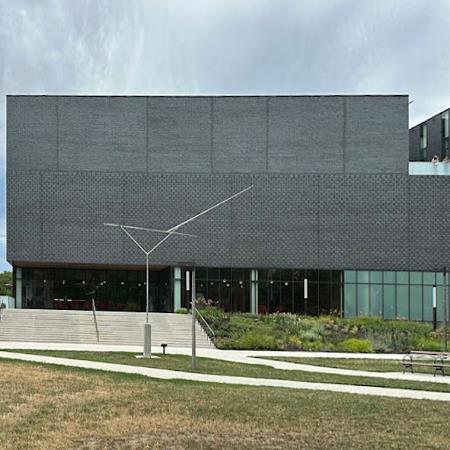University of Iowa Stanley Museum of Art. The University of Iowa Stanley Museum of Art is a visual arts institution that is part of the University of Iowa in Iowa City, Iowa, United States. It is accredited by the American Alliance of Museums. Since its inception, the museum has partnered in many teaching programs and research projects with the University of Iowa School of Art and Art History, and for several decades has sponsored the annual MFA show as well as the faculty exhibitions. Faculty from the SAAH and elsewhere, and graduate students on campus have curated shows at the museum that are closely linked with their research, courses, and seminars. The teaching mission of the Stanley Museum of Art embraces the curriculum of the University of Iowa and extends throughout the state. The University of Iowa Stanley Museum of Art, established in 1969, has one of the top university art collections in the country. Approximately 17,000 objects constitute diverse collections that include paintings, sculpture, prints, drawings, photographs, ceramics, textiles, jade and silver. A number of major art donors contributed to the collection, including Peggy Guggenheim, Owen and Leone Elliott, and Elizabeth M. and C. Maxwell Stanley. The Guggenheim donation includes masterpieces by Pollock, Matta, Seliger, and Rice Pereira. The Elliott Collection includes paintings by Braque, Chagall, De Chirico, Kandinsky, L�ger, Marc, Matisse, Picasso, and Vlaminck, among others. The Stanley Collection of African Art is part of one of the most significant collections of African art in the country which today numbers almost 2,000 objects. Other significant areas of the collections include nearly 5,300 prints spanning the history of Western printmaking, several hundred ceramics, Pre-Columbian objects as well as groups of ancient Etruscan and Roman art, and Native American ledger drawings. Two of the most well-known works in the collections were given to the museum by the School of Art and Art History: Max Beckmann's triptych, Karneval, purchased by the faculty in 1946, and one of the most famous paintings in the world, Jackson Pollock's Mural, created in 1943 for Peggy Guggenheim, which she gave to the school in 1951. Significant paintings by Robert Motherwell, Lyonel Feininger, Maurice Prendergast, Alexej von Jawlensky, Joan Miro, Marsden Hartley, Stuart Davis, Grant Wood, Philip Guston, Ad Reinhardt, Richard Diebenkorn, Yasuo Kuniyoshi, Arthur Dove, Giorgio Morandi, Mark Rothko, Miriam, and Sam Gilliam, as well as sculptural/3-D works by Louise Nevelson, Sol LeWitt, Mark di Suvero, Beverly Pepper, Henry Moore, Marcel Duchamp, Lil Picard, Alexander Calder, Peter Voulkos, and George Rickey add to the museum's offerings. Building the museum In the early 1960s, Owen and Leone Elliott of Cedar Rapids, Iowa, offered the university their extensive collection of 20th-century paintings, prints, antique silver, and jade on the condition that a museum be built to house their gift, along with the university's existing and future acquisitions of art. In response to this challenge, more than 2000 individuals and businesses contributed funds for the museum's construction. The University of Iowa Museum of Art opened in 1969, although the art collections of the University of Iowa predate the museum by several decades. During the 1940s and 1950s, the university's School of Art and Art History presented exhibitions of contemporary art and acquired works from these exhibitions. Many of the museum's most important paintings were acquired during these years, including Max Beckmann's Karneval, and Joan Miro's 1939 A Drop of Dew Falling from the Wing of a Bird Awakens Rosalie Asleep in the Shade of a Cobweb. Jackson Pollock's Mural was given to the university by Peggy Guggenheim in 1953. A gift from the late industrialist Roy Carver, of Muscatine, Iowa, made possible the construction of a major addition, which opened in 1976 and housed the University of Iowa Foundation and the University of Iowa Alumni Association in addition to portions of the museum. Maxwell and Elizabeth Stanley also of Muscatine, collected African art throughout the 1970s and in 1979; most of their collection came to the museum. Renovation The Alumni Association and UI Foundation moved out in 1999, leaving the entire 70,000 square feet of the building to the UI Museum of Art. In the summer of 2003, the long-awaited renovation of the former Alumni Center, or north wing, of the building began. Nearly 30,000 square feet of the building was gutted and substantial changes were made to the mechanical systems and spaces in the basement as well.
more...



